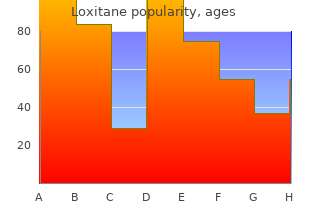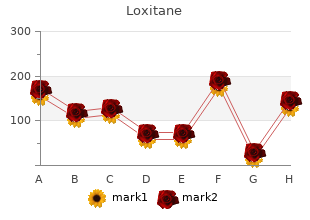Loxitane
"Purchase loxitane 25 mg without prescription, schedule 6 medications."
By: Marieke Kruidering-Hall PhD
- Academy Chair in Pharmacology Education
- Associate Professor, Department of Cellular and Molecular Pharmacology
- University of California, San Francisco

http://cmp.ucsf.edu/faculty/marieke-kruidering-hall
Ideally discount loxitane 25mg with mastercard, a triage officer/committee has expertise working with 159 pediatric patients discount loxitane 10 mg with amex. The color (blue discount loxitane line, purple order loxitane 25 mg with mastercard, yellow, or inexperienced) determines the extent of entry to a ventilator (blue = lowest entry/palliate/discharge, purple = one hundred sixty highest entry, yellow = intermediate entry, and inexperienced = defer/discharge). If sources can be found, patients in the yellow category even have entry to 161 ventilator remedy. If sources turn into obtainable, patients in the blue color category, or these with exclusion criteria, are reassessed and may turn into eligible for ventilator remedy. Patients with a high danger of mortality and poor response to ventilation have a low chance of enhancing inside a reasonable time frame, such that the ventilator could also be allocated to another baby with a higher chance of survival. These patients are supplied 162 with various types of medical intervention and/or palliative care, where acceptable. Finally, the Task Force and the Pediatric Clinical Workgroup acknowledged that the triage course of requires regular reassessments of the standing of the pandemic, obtainable sources, 163 and of all patients. Thus, as new data and details about the pandemic viral strain turn into obtainable throughout a pandemic, the pediatric scientific ventilator allocation protocol could also be revised accordingly to make sure that triage decisions are made commensurate with updated scientific criteria. Ideally, the person or committee should have expertise working with pediatric patients. Some facilities, depending on the supply of specialised employees, may designate a pediatric or neonatal specialist as a member of the triage committee. For an instance of a pediatric triage committee in practice throughout an emergency catastrophe, see Amir Ytzhak et al. Exclusion Criteria the Task Force and the Pediatric Clinical Workgroup decided that though the usage of exclusion criteria may not significantly scale back the number of kids eligible for ventilator 164 remedy, it nonetheless could also be a useful tool in the initial stage of the triage course of. Applying exclusion criteria will establish patients with the best chance of mortality, even with ventilator remedy, to prioritize patients most probably to survive with ventilator remedy in a scenario of scarce sources. Once it had decided that the usage of exclusion criteria was acceptable as an initial triage step, the Pediatric Clinical Workgroup addressed the appropriate time frame of anticipated mortality for a situation to be placed on the exclusion criteria list. The Workgroup agreed that a long window of anticipated mortality, similar to 12 to 24 months, was too troublesome and ambiguous for a doctor to predict with any accuracy. Workgroup members acknowledged that, in many circumstances, kids with severe and certain deadly medical a hundred sixty five circumstances may not essentially have an anticipated mortality inside this shorter window. Thus, the Pediatric Clinical Workgroup decided that because the aim of making use of exclusion criteria is to establish patients with a short life expectancy irrespective of the current acute illness, to be able to prioritize patients most probably to survive with ventilator remedy. The medical circumstances that qualify as exclusion criteria are limited to these related to instant or near instant mortality even with aggressive remedy. Because it might be unimaginable to list each medical situation that may lead to instant or near-instant mortality, the 164 In contrast, the usage of exclusion criteria in the adult scientific protocol will doubtless scale back the number of eligible patients for ventilator remedy more significantly. Both the Task Force and the Pediatric Clinical Workgroup recognized that as with all medical decisions made throughout emergency circumstances, decisions concerning the application of 166 exclusion criteria could also be made with limited details about a patient�s medical history. Any patient whose exclusion criterion was not discovered initially continues to the next triage step. Triage Chart for Step 1 the Pediatric Clinical Workgroup reached consensus on the next exclusion criteria list. This list focuses totally on medical circumstances limited to these related to instant or near-instant mortality even with aggressive remedy. In such cases, hospital employees would reassess patients and extubate these tubes as necessary. However, if a ventilator becomes obtainable and no other patient is in need of ventilator remedy, a patient with an exclusion criterion could also be eligible for this remedy. The Pediatric Clinical Workgroup rejected the usage of a pediatric scientific scoring system at this step of the triage course of. This novel system would supply higher accuracy concerning whether or not a pediatric patient will recuperate with low useful resource use. This system would establish more precisely whether or not a pediatric patient would benefit essentially the most from a short-time period trial of ventilator remedy and would make sure the a hundred twenty five Chapter 2: Pediatric Guidelines be used to evaluate the chance of survival, to decide whether or not a pediatric patient is eligible for ventilator remedy. Physician scientific judgment consists of a structured decision-making course of that rigorously considers solely specific scientific factors based mostly on obtainable medical evidence and not private values or subjective judgments, similar to quality of life. Ideally, to be able to make knowledgeable decisions, the attending doctor and triage officer/committee should have expertise 171 working with kids. The attending doctor�s analysis is predicated solely on scientific criteria, together with the acute severity of a patient�s present medical situation, the epidemiology of the disease, and the existence and standing of any severe underlying diseases or medical circumstances (co-morbidities) 172 which will hinder restoration. A mortality danger prediction is predicated on whether or not a patient may survive the acute medical episode that necessitates ventilator remedy. The Pediatric Clinical Workgroup concluded that in Step 2, physicians can also think about severe, end-stage chronic medical circumstances when assessing mortality danger. The presence of comorbidities complicates a patient�s capability to survive and can also cause the patient�s acute greatest number of survivors. The first step to obtain the objective of such a pediatric scientific scoring system was performed. Although the proposed system has vital strengths, together with being developed using solely evidence-based mostly scientific data to information useful resource allocation, validation has not but been revealed. These facilities have to make lodging to implement this recommendation, similar to provide pediatric health care coaching to a triage officer/committee. Instead, physicians should look at a patient�s total health to evaluate the patient�s present health standing. In some circumstances, a patient with a severe medical situation may require 173 ventilator remedy due to influenza and not due to the chronic care disease itself.
Syndromes
- Colon biopsy
- Male reproductive organs including the testes, epididymis, vas deferens, seminal vesicles, prostate, and penis
- To what extent have you lost your voice (all or partially)?
- Persons with a weakened immune system due to certain cancers and their treatment, HIV, steroid medicines, or other medicines that suppress the immune system.
- Slow or rapid heart rate
- Shortened life span
- Bleeding
- Name of the product (ingredients and strengths, if known)

Know that genetic determinants for stature and ovarian improvement are coded by completely different genes on the X-chromosome 2 purchase 10mg loxitane mastercard. Know the completely different karyotypes that may lead to purchase loxitane visa Turner syndrome and the resulting clinical features four purchase 25mg loxitane visa. Know the danger of malignant degeneration of gonads in patients with gonadal dysgenesis and Y chromosomal materials and the methods of figuring out Y materials 5 discount loxitane 10mg without a prescription. Know the sample of gonadotropin secretion in gonadal dysgenesis as a function of age in women and the rationale that it differs from a standard woman c. Know the time course of changes in ovarian morphology in the improvement of ovarian failure, including the decline in ovum at various stages 2. Know the typical linear growth sample of youngsters with Turner syndrome in the fetus and after start three. Know the congenital cardiovascular abnormalities of ladies with Turner syndrome and contrast them with Noonan syndrome four. Know the increased incidence of autoimmune thyroiditis, celiac disease, and sort 1 diabetes in kids with Turner syndrome 5. Recognize the changes in the skeleton, including limb and vertebral abnormalities, in Turner syndrome that may be observed on x-ray research 6. Know that Madelung deformity of the wrist happens in some individuals with Turner syndrome 7. Recognize the cytogenetic findings that are related to cognitive impairment in women with Turner syndrome 9. Understand the habits and psychologic problems that may be present in women with Turner syndrome d. Know the professionals and cons of estrogen therapy with completely different estrogen preparations in Turner syndrome including relative dosage and age of initiation of therapy four. Know the outcome of growth hormone, estrogen and androgen therapy for Turner syndrome on metabolic changes and physical improvement 2. Know the professionals and cons of remedy of Klinefelter syndrome with testosterone, including relative dosage and age of initiation of therapy f. Know the relative danger of breast most cancers is increased in individuals with Klinefelter syndrome b. Know the principles underlying intercourse task in individuals with genital ambiguity 2. Recognize the relative dangers for malignancy in numerous problems of gonadal improvement three. Understand the correlation between the genital phenotype and the timing of inadequate androgen secretion or action during intercourse differentiation three. Know the completely different syndromes resulting from embryonic or fetal testicular dysgenesis at various occasions between eight to forty weeks gestation four. Understand the way to recognize and diagnose the genetic defects in testosterone and dihydrotestosterone synthesis 6. Differentiate the clinical and genetic features of androgen receptor defects from alpha-reductase deficiency 7. Know the heredity of testicular enzyme defects, androgen insensitivity, and 5 alpha-reductase deficiency eight. Understand the effects of untreated testosterone biosynthetic defects, androgen insensitivity syndromes, and 5 alpha-reductase deficiency on pubertal sexual improvement 10. Know the way to distinguish virilizing congenital adrenal hyperplasia as a cause of virilization from placental aromatase deficiency and maternal causes (luteoma, exogenous adrongens) three. Know the kinds of hormones and medicines ingested by the mother that might trigger fetal virilization 5. Be aware of problems of embryonic improvement that result in genital abnormalities b. Know the role of diethylstilbestrol in irregular Mullerian epithelium improvement in subsequent generations 2. Know that micropenis could result from hypopituitarism or primary defects in testosterone secretion or action 2. Recognize that micropenis may be related to different hormonal deficiencies resulting in hypoglycemia and nystagmus three. Recognize that micropenis may be the only phenotypic feature of pituitary dysfunction b. Know the impact of varied kinds of androgen remedy in infancy on micropenis later in life four. Recognize that the timing and sequence of pubertal changes could differ amongst completely different ethnic teams and in numerous countries b. Know the approximate ages for Tanner stages 2-5 of breast improvement and the typical period of each stage three. Know that adrenarche is characterized by will increase in adrenal androgens, the type of androgens, and the looks of androgenic effects 2. Know the approximate ages for Tanner stages 2-5 of pubic hair improvement and the expected relationship to breast improvement c. Know the decrease restrict of regular phallic length at each stage of pubertal improvement four. Know the typical chronologic and bone ages for menarche and the relationship to early and late puberty b. Know the typical chronologic and bone ages for spermarche and the relationship to early and late puberty c.
Purchase loxitane. I CAN'T GET "IT" UP!!! (How To FIX Erectile Dysfunction FAST).

Respiratory Problems � Related to buy cheap loxitane on line compromised respiratory perform; severity is dependent upon stage of harm discount 10mg loxitane mastercard. The muscle tissue innervated by the a part of the twine phase located beneath the extent of the lesion become completely paralyzed and accid cheap 10 mg loxitane free shipping, and the re exes are absent order cheap loxitane online. Parts of the body beneath the extent of the twine lesion are paralyzed and with out sensation. Emergency Management � Immediate affected person administration on the accident scene is cru cial. S � Maintain affected person in an extended place (not sitting); no body half ought to be twisted or turned. The affected person is resuscitated as necessary, and oxygenation and car diovascular stability are maintained. High-dose corticosteroids (methylprednisolone) could also be administered to counteract spinal twine edema. Extreme care is taken to keep away from exing or extending the neck if endotracheal intubation is necessary. Diaphragm pacing (elec trical stimulation of the phrenic nerve) could also be considered for patients with excessive cervical backbone injuries. The cervical fracture is decreased and the cervical backbone aligned with a form of skele tal traction (using skeletal tongs or calipers or the halo-vest method). The objectives of sur gical remedy are to preserve neurologic perform by remov ing stress from the spinal twine and to present stability. Management of Complications Spinal and Neurogenic Shock � Intestinal decompression is used to deal with bowel distention and paralytic ileus brought on by melancholy of re exes. This loss of sympathetic innervation causes a wide range of other scientific manifestations, including neurogenic shock signaled by decreased cardiac output, venous pooling in the extremities, and peripheral vasodilation. Spe cial issues embrace decreased vital capacity, decreased oxygen ranges, and pulmonary edema. Patient is monitored for respiratory problems (respiratory failure, pneumonia). Symptoms 606 Spinal Cord Injury embrace pleuritic chest pain, anxiousness, shortness of breath, and abnormal blood gas values. A permanent indwelling lter could also be placed in the vena cava to forestall dislodged clots (emboli) from migrating to the lungs and inflicting pulmonary emboli. S � Monitor affected person carefully for any modifications in motor or sensory perform and for signs of progressive neurologic injury. Spinal Cord Injury 607 � Assess for gastric dilation and paralytic ileus due to atonic bowel. Nursing Interventions Promoting Adequate Breathing and Airway Clearance � Detect potential respiratory failure by observing affected person, measuring vital capacity, and monitoring oxygen saturation via pulse oximetry and arterial blood gas values. Apply a neck brace or molded collar when the affected person is mobilized after traction is removed. Spinal Cord Injury 609 Promoting Adaptation to Disturbed Sensory Perception � Stimulate the realm above the extent of the harm via contact, aromas, avorful food and drinks, conversation, and music. Maintaining Skin Integrity � Change affected person�s place every 2 hours, and inspect the skin, significantly under cervical collar. Keep stress-delicate areas nicely lubricated and delicate with bland cream or lotion. Maintaining Urinary Elimination � Perform intermittent catheterization to keep away from overstretch ing the bladder and infection. S � Teach affected person to record uid intake, voiding pattern, quantities of residual urine after catheterization, characteris tics of urine, and any uncommon emotions. If one of many pins turns into indifferent, stabilize the affected person�s head in a impartial place and have someone notify the neurosurgeon; keep a torque screwdriver available. Provide antiembolism stockings and stomach binders; enable time for slow place modifications, and use tilt tables as acceptable. Inform affected person with lesion above T6 that hyperre exic episode can occur years after initial harm. As the affected person and household acknowledge the implications of the harm and the resulting disability, broaden the focus of teaching to tackle points necessary for finishing up the duties of day by day residing and taking cost of their lives. Evaluation Expected Patient Outcomes � Demonstrates enchancment in gas change and clearance of secretions � Moves within limits of dysfunction, and demonstrates completion of workouts within useful limitations � Demonstrates adaptation to sensory and perceptual alter ations 612 Syndrome of Inappropriate Antidiuretic Hormone � Demonstrates optimum skin integrity � Regains urinary bladder perform � Regains bowel perform � Reports absence of pain and discomfort � Is free of problems For extra information, see Chapter sixty three in Smeltzer, S. Other causes embrace severe pneumonia, pneumothorax, other issues of the lungs, and malignant tumors that have an effect on other organs. Nursing Management � Monitor uid intake and output, day by day weight, urine and blood chemistries, and neurologic standing. Systemic Lupus Erythematosus 613 For extra information, see Chapter 42 in Smeltzer, S. Pathophysiology this disturbance is led to by some mixture of genetic, hormonal (as evidenced by the same old onset during the childbearing years), and environmental components (daylight, ther mal burns). S � Classic signs: fever, fatigue, weight loss, and presumably arthritis, pleurisy. Joint swelling, tenderness, and pain on motion are widespread, accompanied by morn ing stiffness. A butter y rash throughout the bridge of the nostril and cheeks happens in more than half of patients and could also be a precursor to systemic involvement. Lesions worsen throughout exacerbations (� ares�) and could also be 614 Systemic Lupus Erythematosus provoked by daylight or arti cial ultraviolet light. Papular, erythematosus, and purpuric lesions may occur on ngertips, elbows, toes, and extensor surfaces of forearms or lateral sides of palms and may progress to necrosis.
Diseases
- Cowpox
- Ornithine aminotransferase deficiency
- Occupational asthma - wood
- Hyperlipoproteinemia
- Acrofrontofacionasal dysostosis
- Marchiafava Micheli disease
- De Hauwere Leroy Adriaenssens syndrome
- Acoustic neuroma
